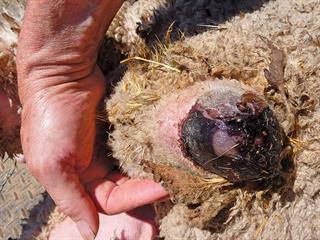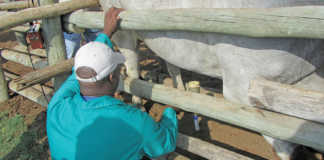
Pizzle rot (peestersiekte) occurs mainly during the mating season. It is transmitted from ram to ewe to ram, but has also been observed in young rams that have never been with a ewe. The bacteria that causes pizzle rot is unknown, therefore its means of transmission is also not understood. Deficiency diseases, poor nutrition and excessive intake of protein seem to aggravate the condition.
One source suggests that two main factors are involved. The first is the bacterium Corynebacterium renale, or one of that group. These bacteria break down urea, the nitrogen-containing substance in the urine of mammals. The second factor is an increase in the protein level of the diet, which is fairly common in the month before breeding as farmers try to improve the condition of rams. Once the protein in the diet sources rises above 16%, urine can contain more than 4% urea.
Signs
The bacteria break down the urea, releasing ammonia. Because there is more urea than normal at this stage, the excess ammonia causes sores (ulceration) and a severe irritation of the skin around the preputial opening. Once the skin is ulcerated, C. renale or other bacteria infect it.
Symptoms in rams are inflammation of the penis and sheath. This ranges from small pustules and wounds on the penis to a penis that is considerably swollen and bleeds, and from which pieces of tissue slough off. The penis is also caked with pus. Hence the disease’s common name: pizzle is an Old English word meaning ‘penis’.
The infected ulcers can spread through the opening to the mucosa of the preputial cavity. Internal ulceration is painful; the prepuce, containing old urine and debris, becomes enlarged and swollen. If there is severe interference with urination, the ram may become uremic and die. Once the opening is blocked, urea dribbles out to stain the surrounding wool. Fly strike often follows ulceration and urine-soiling of the preputial area.
The condition is at its worst during the breeding season. The penis often hangs out at this time and can be so painful that the ram cannot service. Even if the ram can breed, it should not be used; venereal transmission to the ewe causing an ulcerative vulvitis has been reported. Ewes contract the disease during servicing. Symptoms are a bloody discharge and sores on the vulva. Apparently the condition does not affect fertility and ewes recover by themselves within a few weeks.
Treatment
Affected rams must be removed from the flock and isolated. If practical, affected ewes must also be maintained separately
With the ram in a sitting position, pull out the penis and spray with an aerosol antibiotic. Administer a long-term antibiotic and isolate the ram for three weeks. One treatment is enough. Further handling of the penis can aggravate the condition.
To stop dirt contaminating the treated area, the ram should be bedded on a good layer of clean straw until the ulcer has healed. External ulcers can take from a few weeks to six months to heal. A ram with pizzle rot should not be used for breeding until the ulcers have healed completely.
Prevention
- Deficiency diseases should be eliminated, as they lower resistance;
- Rams should not be overfed during the mating season;
- All rams should be checked before the mating season. Any with sores or wounds on the penis should be removed;
- Combat ticks on sheep throughout the year. Ticks may play a role in the transmission of the disease;
- Consider adjusting the protein level of the diet to below the critical 16%. Do this through forage analysis and a ration formulation based on that analysis for each stage of production.
Sources: The Merck Veterinary Manual (merckvetmanual.com); ‘Pizzle rot in sheep’, by Dr S John Martin, Veterinary Scientist, Sheep, Goat and Swine/OMAFRA (www.omafra.gov.on.ca); infopak by AO de Kock, Elsenburg/Vredenal veterinary services.












